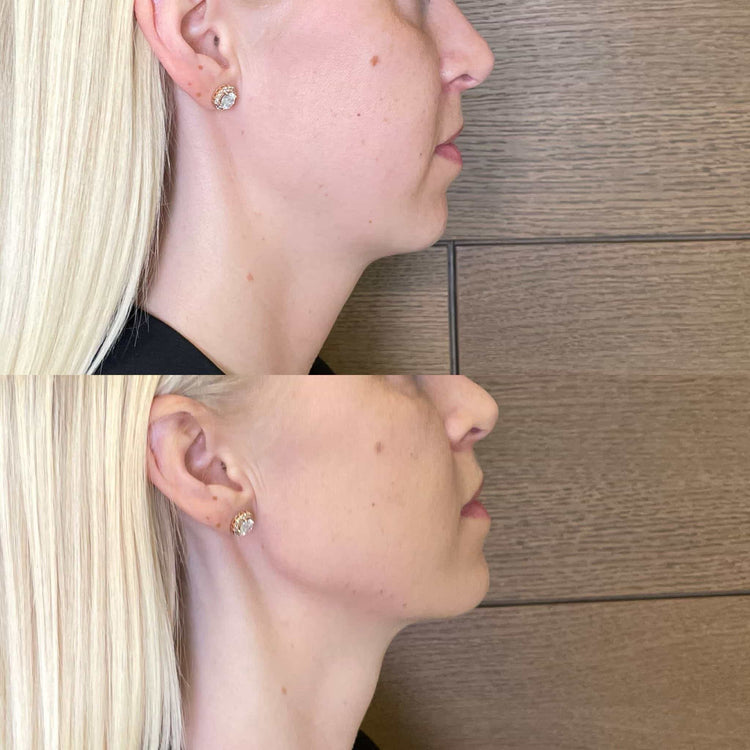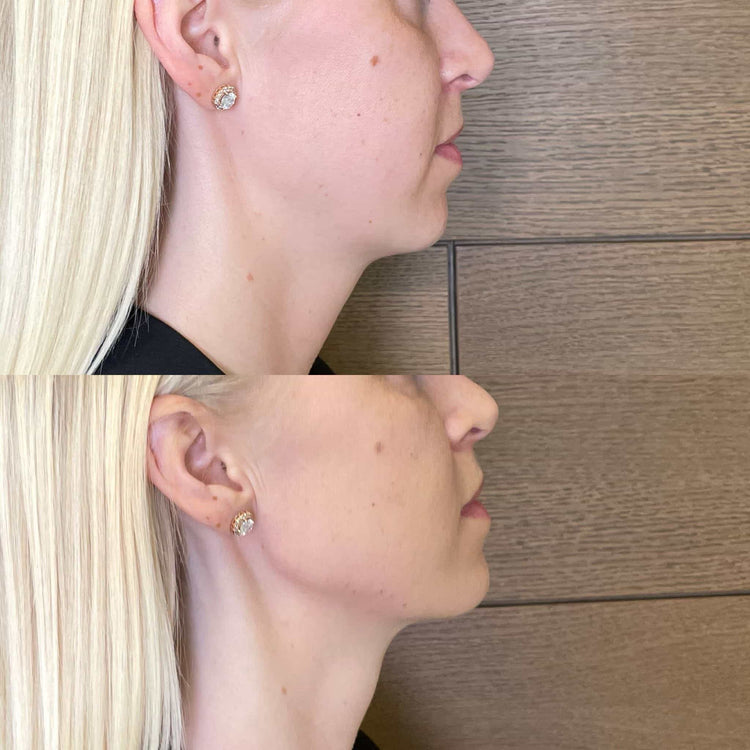The Science of Facial Aging
The intricate tapestry of facial aging unveils a multitude of transformations, from subtle shifts in skin elasticity to pronounced changes in bone structure. Among these changes, the jawline often bears the brunt of time’s passage, gradually losing its sharpness and definition. This erosion can lead to a less sculpted appearance, contributing to a sense of weariness or even years added to one’s visage.
How Fat Loss Affects the Jawline
The loss of jawline definition is primarily attributed to age-related fat depletion in the lower face. As we age, our bodies naturally produce less collagen and elastin, the proteins responsible for maintaining skin firmness and structure. This decline leads to a softening of the jawline’s contours as the underlying fat pads shrink and redistribute.
This loss of volume can create a less defined jawline, making it appear rounded or blurred. The angle between the jaw and the neck may also become less pronounced, further contributing to a less sculpted appearance.
Bone Structure Changes Over Time
The loss of jawline definition is primarily attributed to age-related fat depletion in the lower face. As we age, our bodies naturally produce less collagen and elastin, the proteins responsible for maintaining skin firmness and structure. This decline leads to a softening of the jawline’s contours as the underlying fat pads shrink and redistribute.

This loss of volume can create a less defined jawline, making it appear rounded or blurred. The angle between the jaw and the neck may also become less pronounced, further contributing to a less sculpted appearance.
Fortunately, advancements in cosmetic science have provided effective solutions to restore youthful definition to the jawline. Jaw fillers are injectables composed of hyaluronic acid, a naturally occurring substance that attracts and retains moisture.
- Jaw fillers work by adding volume beneath the skin, plumping up the cheeks and restoring the angle between the jaw and the neck.
- They also stimulate collagen production, further enhancing the longevity of results.
Jaw Fillers: A Non-Surgical Solution
The passage of time inevitably leaves its mark on our facial features. One area that often shows signs of aging is the jawline. As we age, a natural loss of fat and collagen can lead to a less defined jaw, resulting in a softer, less sculpted appearance. This can make individuals appear older than they feel.
Dermal Fillers and Their Composition
Jaw fillers offer a non-surgical solution to restore definition to aging jawlines. These injectables are composed of hyaluronic acid, a substance naturally found in the body that acts as a humectant, drawing moisture and plumping the skin.
Dermal fillers work by strategically injecting hyaluronic acid beneath the skin. This added volume helps to fill in areas where fat has diminished over time, effectively restoring the sharpness and definition of the jawline.
The placement of filler is crucial for achieving optimal results. A skilled practitioner will carefully analyze facial structure and individual needs to determine the precise locations for injection.
Types of Fillers Used for Jaw Enhancement
Jaw fillers provide a non-surgical approach to restoring youthful definition to the jawline. These injectables contain hyaluronic acid, a naturally occurring substance that attracts and retains moisture.
Different types of hyaluronic acid-based fillers are used for jaw enhancement. Some common types include:
- Calcium Hydroxylapatite (CaHA): This type of filler provides long-lasting results and is known for its ability to stimulate collagen production.
- Poly-L-lactic Acid (PLLA): PLLA fillers are gradually absorbed by the body, prompting collagen growth over time. They offer a more gradual volumization effect that lasts for several months.
- Hyaluronic Acid Fillers: Various hyaluronic acid fillers are available, with different consistencies and formulations tailored to specific areas of the face.
The choice of filler depends on individual needs and desired outcomes. Factors considered include skin elasticity, the degree of volume loss, and the patient’s aesthetic goals.
Procedure and Aftercare
Understanding the procedure and aftercare involved is essential for anyone considering jaw fillers. The procedure itself is relatively quick and minimally invasive, typically performed in a clinic setting with local anesthesia. After the injection, patients may experience some temporary swelling, bruising, or redness, which can be managed with ice packs and over-the-counter pain relievers.
Consultation and Treatment Planning
Consultation plays a crucial role in determining if jaw fillers are suitable for you. During this consultation, a qualified practitioner will assess your facial structure, discuss your aesthetic goals, and address any concerns you may have. They will explain the procedure in detail, outlining the potential benefits and risks involved.
The treatment itself is relatively quick and straightforward. Local anesthesia is typically used to ensure your comfort during the procedure. The practitioner will strategically inject the chosen filler beneath the skin along the jawline, aiming to restore volume and definition.
Following the procedure, you may experience some mild swelling, bruising, or redness, which usually subsides within a few days. Ice packs and over-the-counter pain relievers can help manage any discomfort. You will be advised on aftercare instructions to optimize healing and minimize potential complications.
It’s important to avoid strenuous activity, excessive heat, and direct sun exposure for several days post-treatment.
Results from jaw fillers are typically visible immediately or within a few days, with full effects becoming apparent after a week or two as the swelling subsides.
The longevity of results varies depending on individual factors such as metabolism and lifestyle choices. Most patients see benefits for 6 to 18 months, after which touch-up injections may be required to maintain the desired outcome.

Injection Process and Duration
Understanding the procedure and aftercare involved is essential for anyone considering jaw fillers. The procedure itself is relatively quick and minimally invasive, typically performed in a clinic setting with local anesthesia. After the injection, patients may experience some temporary swelling, bruising, or redness, which can be managed with ice packs and over-the-counter pain relievers.
- Procedure: The treatment itself is relatively quick and straightforward. Local anesthesia is typically used to ensure your comfort during the procedure. The practitioner will strategically inject the chosen filler beneath the skin along the jawline, aiming to restore volume and definition.
- Aftercare: Following the procedure, you may experience some mild swelling, bruising, or redness, which usually subsides within a few days. Ice packs and over-the-counter pain relievers can help manage any discomfort. You will be advised on aftercare instructions to optimize healing and minimize potential complications. It’s important to avoid strenuous activity, excessive heat, and direct sun exposure for several days post-treatment.
Results from jaw fillers are typically visible immediately or within a few days, with full effects becoming apparent after a week or two as the swelling subsides.
The longevity of results varies depending on individual factors such as metabolism and lifestyle choices. Most patients see benefits for 6 to 18 months, after which touch-up injections may be required to maintain the desired outcome.
Recovery Time and Post-Treatment Instructions
Understanding the procedure and aftercare involved is essential for anyone considering jaw fillers. The procedure itself is relatively quick and minimally invasive, typically performed in a clinic setting with local anesthesia. After the injection, patients may experience some temporary swelling, bruising, or redness, which can be managed with ice packs and over-the-counter pain relievers.
- Procedure: The treatment itself is relatively quick and straightforward. Local anesthesia is typically used to ensure your comfort during the procedure. The practitioner will strategically inject the chosen filler beneath the skin along the jawline, aiming to restore volume and definition.
- Aftercare: Following the procedure, you may experience some mild swelling, bruising, or redness, which usually subsides within a few days. Ice packs and over-the-counter pain relievers can help manage any discomfort. You will be advised on aftercare instructions to optimize healing and minimize potential complications. It’s important to avoid strenuous activity, excessive heat, and direct sun exposure for several days post-treatment.
Results from jaw fillers are typically visible immediately or within a few days, with full effects becoming apparent after a week or two as the swelling subsides.
The longevity of results varies depending on individual factors such as metabolism and lifestyle choices. Most patients see benefits for 6 to 18 months, after which touch-up injections may be required to maintain the desired outcome.
Benefits of Jaw Fillers in London
In London, jaw fillers offer a non-surgical solution to restore definition to aging jawlines. This treatment utilizes hyaluronic acid, a naturally occurring substance in the body that attracts and retains moisture, to plump up the cheeks and enhance the angle between the jaw and neck. The result is a more youthful, sculpted appearance.
Restoring Youthful Contour
Jaw fillers provide a non-surgical solution to restore definition to aging jawlines in London. These injectables are composed of hyaluronic acid, a substance naturally found in the body that acts as a humectant, drawing moisture and plumping the skin.
Dermal fillers work by strategically injecting hyaluronic acid beneath the skin. This added volume helps to fill in areas where fat has diminished over time, effectively restoring the sharpness and definition of the jawline.
The benefits of jaw fillers extend beyond a simply more defined appearance. They can help to:
- Enhance facial harmony by balancing proportions
- Improve self-confidence and overall aesthetic appeal
- Reduce the appearance of wrinkles and fine lines around the jawline
A skilled practitioner will carefully analyze facial structure and individual needs to determine the precise locations for injection, ensuring optimal results.
Jaw fillers offer a relatively quick, minimally invasive procedure with minimal downtime. Most patients see benefits immediately or within a few days, with full effects becoming apparent after a week or two as the swelling subsides.
Enhancing Facial Symmetry
In London, jaw fillers offer a non-surgical solution to restore definition to aging jawlines. This treatment utilizes hyaluronic acid, a naturally occurring substance in the body that attracts and retains moisture, to plump up the cheeks and enhance the angle between the jaw and neck. The result is a more youthful, sculpted appearance.
Jaw fillers provide a non-surgical solution to restore definition to aging jawlines in London. These injectables are composed of hyaluronic acid, a substance naturally found in the body that acts as a humectant, drawing moisture and plumping the skin.
Dermal fillers work by strategically injecting hyaluronic acid beneath the skin. This added volume helps to fill in areas where fat has diminished over time, effectively restoring the sharpness and definition of the jawline.
The benefits of jaw fillers extend beyond a simply more defined appearance. They can help to:
- Enhance facial harmony by balancing proportions
- Improve self-confidence and overall aesthetic appeal
- Reduce the appearance of wrinkles and fine lines around the jawline
A skilled practitioner will carefully analyze facial structure and individual needs to determine the precise locations for injection, ensuring optimal results.
Jaw fillers offer a relatively quick, minimally invasive procedure with minimal downtime. Most patients see benefits immediately or within a few days, with full effects becoming apparent after a week or two as the swelling subsides.
Boosting Self-Confidence
Jaw fillers have become increasingly popular in London for their ability to restore definition and youthfulness to the jawline. This non-surgical treatment offers a subtle yet transformative solution to combat age-related volume loss and sagging, contributing to a more sculpted and confident appearance.
The benefits of jaw fillers extend far beyond just physical aesthetics. By enhancing facial features and restoring lost definition, they can have a profound impact on self-confidence and overall well-being.
Individuals who may consider jaw fillers often seek to address concerns such as:
- Loss of jawline definition
- Rounded or blurred jaw contours
- Sagging neck appearance
- A desire for a more youthful and sculpted profile
The procedure involves injecting hyaluronic acid, a naturally occurring substance in the body, beneath the skin along the jawline. This volumizes the area, restoring sharpness to the angles and creating a more defined silhouette.
Choosing a Qualified Practitioner
When considering cosmetic enhancements like jaw fillers, choosing a qualified practitioner is paramount. Their expertise ensures safe and effective treatment tailored to your individual needs and goals. Look for practitioners with extensive experience in facial aesthetics, particularly those specializing in jaw filler treatments.
Importance of Experience and Expertise
Choosing a qualified practitioner is essential when considering any cosmetic procedure, especially something like jaw fillers which directly impact facial structure.
- **Experience and Expertise:** Seek out practitioners who have significant experience performing jaw filler injections. Inquire about their training, certifications, and the number of successful treatments they have completed.
- **Portfolio and Patient Reviews:** Review before-and-after photos of previous patients to gauge the practitioner’s skill and aesthetic sense. Look for patient testimonials or reviews online to get insights into others’ experiences.
- **Consultation:** Schedule a consultation with potential practitioners. This allows you to discuss your goals, concerns, and medical history. A good practitioner will listen carefully, answer your questions thoroughly, and provide realistic expectations about the results.
Remember, investing in a qualified practitioner ensures your safety, well-being, and ultimately, the best possible outcome for your desired aesthetic enhancement.
Checking Credentials and Qualifications
Choosing a qualified practitioner is crucial when considering jaw fillers. Their expertise ensures safe and effective treatment tailored to your individual needs and goals.
Here are some factors to consider when choosing a practitioner:
* **Experience and Expertise:** Seek out practitioners who have significant experience performing jaw filler injections. Inquire about their training, certifications, and the number of successful treatments they have completed.
* **Portfolio and Patient Reviews:** Review before-and-after photos of previous patients to gauge the practitioner’s skill and aesthetic sense. Look for patient testimonials or reviews online to get insights into others’ experiences.
* **Consultation:** Schedule a consultation with potential practitioners. This allows you to discuss your goals, concerns, and medical history. A good practitioner will listen carefully, answer your questions thoroughly, and provide realistic expectations about the results.
Remember, investing in a qualified practitioner ensures your safety, well-being, and ultimately, the best possible outcome for your desired aesthetic enhancement.
Consulting with Multiple Practitioners
Choosing a qualified practitioner is paramount when considering any cosmetic procedure, especially those involving facial aesthetics like jaw fillers. A skilled practitioner will possess extensive knowledge of facial anatomy, injection techniques, and the nuances of hyaluronic acid fillers to achieve natural-looking, harmonious results.
When consulting with multiple practitioners, it’s important to ask about their experience specifically with jaw filler treatments. Inquire about the types of fillers they use, their training in facial aesthetics, and whether they have a portfolio showcasing past jaw filler procedures. Don’t hesitate to ask for references or seek reviews from previous patients to gain insights into their experiences.
A thorough consultation allows you to discuss your aesthetic goals, concerns, and medical history with the practitioner. This open communication ensures they understand your vision and can tailor the treatment plan accordingly. Pay attention to how well they listen to your needs and if they address your questions comprehensively.
Achieve natural jawline contouring with jaw fillers by Dr. Laura Geige at It’s Me & You Clinic
- Hypnotism Fetish: Power And Suggestion In Erotic Play - September 23, 2025
- Dermal Fillers Near Dormansland, Surrey - September 22, 2025
- How To Smooth A Dimpled Chin Using Dermal Fillers - September 21, 2025
